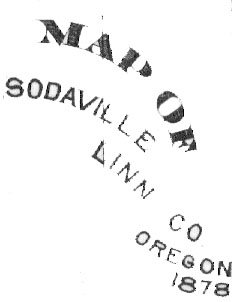Sodaville |
|
|
Sodaville or Soda Springs — Summer’s Soda as it was once known to old-timers — owes its existence to Ruben Coyle (a pioneer of 1847 and a member of the Oregon Constitutional Convention) who took up a land claim in the vicinity in 1847 (112). One day while he was riding through the bare, fern-covered hills searching for strayed oxen, he came upon a spring. He alighted to drink and noticed that the rocks about it were encrusted with rust-red deposit, and when he drank he thought for a moment that he had been poisoned, for the water had a pungent, though not unpleasant taste. He was reassured when he realized that the cattle ranging the hills drank from the spring and were none the worse for it; also when he noticed deer tracks leading to it, and that other animals and birds must get their water here (113). After the discovery of the spring, neighboring
settlers began to patronize it. With Coyle in 1847 had arrived William
Klum, and Richard Usher. Others who early figured in the development of
the region were John Coyle, Caleb Burge, Hiram Klum, W. B. Gibson, M.
Vanderpool and Thomas Summers. Naturally, interest was keen about on
whose land the spring was. It was finally decided it was on the claim of
Thomas Summers; however, owing to happy-go-lucky surveying, the
spring was also found to be on the claim of a Mr. Lee. Result of this
was litigation — which drew out for 18 years. At last, on May 4, 1871,
full title was lawfully vested in Summers. He immediately deeded a lot
99 feet square, with the spring in the center, to the public so that the
water could be free for ever after, and at the same time laid out the
town of Sodaville. The place was incorporated November 8, 1880 (114).
The original town plat contained 12 blocks; later Summers Addition added
as many more (115). Finally the town was enlarged to take in an entire
square mile. The soda springs were really the sole excuse for the town’s existence. It is true that Oak Creek, which flows through the region, is a sort of power source; here Asa Peterson built a saw and grist mill in 1852, but the venture was short-lived. In 1876 Soda Springs was mentioned as follows (116): “SODA SPRINGS or Sodaville, also known as Summer Soda, is a small village which has grown up around the famous mineral spring... “During the summer months, the place presents quite an animated appearance, the neighboring hill being dotted with numerous tents of visitors, who come from all sides to enjoy the soda and the social intercourse. “There is a good hotel, where board can be obtained at reasonable rate also a livery stable. Quite a number of elegant cottages have been added lately, which give it quite a fashionable appearance. The waters have a pungent but not unpleasant flavor, resembling seltzer. They are known to be beneficial in diseases of the liver, dyspepsia, and some skin diseases.” The first spring house at Sodaville was an octagonal open shed. In 1892 the legislature appropriated money to erect the present building. The interior, however remained unfinished until 1895. In 1901 the legislature allowed $1,000 for improvement of building and grounds, and an additional sum in 1921 for improvements and repairs (115). Active in the promotion of Sodaville’s growth was the Sodaville Concert Band, organized April 17,1891, and incorporated February 9, 1895. Under able leaders it became a success both as a musical organization and a business proposition, and its fame spread up and down the valley. In 1896 the band built Sodaville’s largest business block, a frame structure with mercantile space on the first floor and a hall and theater above (117). It continued active until 1904. In 1921 the Band building was destroyed by fire. Sodaville’s chief period of prosperity corresponds to that of the Band. In 1890 there were the following business houses in the town (118): Hardman’s Hotel, Klum’s Hotel; H. M. Peery & Wm. Smith, meat market; James Pound, blacksmithing and wood work; R. Roberts, drug store; Thomas McCulloch, grocery; Frank Davis, postmaster and general store; Peery & Terhune, livery stable. There were also a barber shop, a doctor’s office, a telegraph office and three churches — Free Methodist, Evangelical and Cumberland Presbyterian - a newspaper, the Sodaville Review published from January 21 to May 1, 1893. In 1892 the Sodaville Railroad Company was promoted, a roadbed was graded between Sodaville and Lebanon, but no rails were ever laid (113). By about 1910 the town had become so peaceful and sleepy that a blind man, George Price, was elected city marshal and served with distinction (115). Sodaville’s population, according to the U. S. Census, fluctuated as follows:
Mrs. Ida Parrish Ireland tells of early conditions in the Sodaville.
|
Sodaville Quick Facts Location: Twp 12S, Rge 2W, Sect 36 Name Origin: Descriptive of mineral springs in area. Other Names: Soda Springs, Summer's Soda Post Office Established: 16 Apr 1873 First Postmaster: William A. Peterson Discontinued: 8 Dec 1933 Incorporation Date: 1880 Population 1999: 275 Photos: Mineral Springs College at Sodaville More Links: Reuben Stringer Coyle and Hannah Carroll Coyle, Emigrants of 1847 |
||
Town histories were abstracted from: "History of Linn County",
Compiled by Workers of the Writer’s Program, Works Progress
Administration, 1941. See bibliography
for above-cited references. All photos from the collection of Lisa
L. Jones, unless otherwise noted. Lisa
L. Jones contributed and is solely responsible for the content of
these pages. Copyright 2001.
